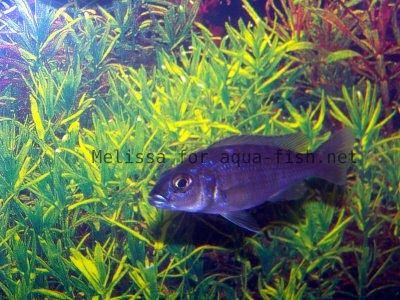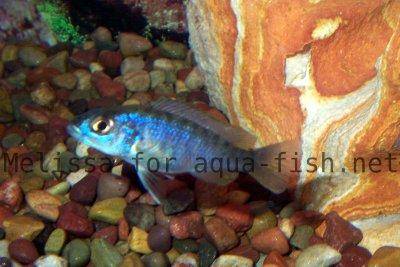Electric Blue Hap: Comprehensive Guide to Care, Breeding, and Behavior
Quick Links
Brief Description
Explore our comprehensive guide on Electric Blue Hap care. This page covers essential aspects including habitat, behavior, diet, and breeding. If you have any unanswered questions or wish to share your experiences, please use the form at the bottom of the page.
The Electric Blue Hap, scientifically known as Sciaenochromis fryeri, is also referred to as Sciaenochromis ahli, Cyrtocara ahli, or Haplochromis ahli due to historical naming variations. Despite its correct scientific name being Sciaenochromis ahli, these alternate names persist due to tradition. The striking "Electric Blue" nickname comes from the vivid blue coloration males develop upon reaching maturity. Initially misclassified as a Haplochromine, this cichlid thrives in environments where rocky shores transition to sandy lake bottoms.
Natural Habitat:
Native to Lake Malawi, the Electric Blue Hap favors regions where rocky cliffs meet sandy lake beds. This species is found along the coasts of Malawi, Mozambique, and Tanzania, preferring deeper waters near rocky outcrops.
Water Conditions:
For optimal care, maintain a water pH between 7.5 and 8.5, with temperatures ranging from 24 to 26°C (75 to 78°F). Provide a habitat with rocky caves and a sandy substrate. Given their high activity level, avoid live plants as they may be uprooted. Instead, use durable, hardy plants or artificial plants that can withstand their digging.
Physical Description:
This cichlid has a laterally compressed body with a long snout and large mouth. Males exhibit brilliant metallic blue coloration, while females and juveniles display a more subdued blue with grayish tones. The dorsal fin features a white edge, and the anal fin has an orange tinge. Males also have “dummy egg spots” on their anal fins, which are important for breeding. Typically, the Electric Blue Hap has 8 to 10 vertical stripes that become more pronounced during aggression or breeding. With proper care, this fish can live up to 11 years or more.
Behavior:
The Electric Blue Hap is known for its aggressive nature and desire to dominate its environment. Even in the presence of larger fish, it may assert its control. If faced with more aggressive or larger species, it might retreat but will dominate smaller, timid fish and may prey on them. To ensure compatibility, house this species with other aggressive cichlids of similar size, especially those native to Lake Malawi, like Malawi cichlids.
Diet & Feeding:
Electric Blue Haps are natural predators with a preference for small fish, including the fry of other species. They are not suitable tankmates for smaller fish. In captivity, they will eat a variety of foods, including flakes, pellets, vegetable matter, and live, dried, or frozen foods. Providing a varied diet helps maintain their health and vibrant coloration.
Sexing:
Males are distinguished by their vivid metallic blue coloration and “dummy egg spots” on their anal fins, essential for breeding. Females and juveniles have a more subdued blue color with grayish hues and lack the egg spots.
Breeding:
For successful breeding, keep one male with 3 to 5 females. Housing only one female with a male can be risky, as the male may become overly aggressive and harm the female if she is not ready to spawn. A group of females allows the male to choose a mate and reduces stress. Provide rocky caves or hiding places to give females a retreat when the male is aggressive.
Electric Blue Haps are mouthbrooders, meaning the female carries fertilized eggs in her mouth until they hatch. This process typically lasts about three weeks. The male digs a pit for the eggs, and the female collects them in her mouth. She stimulates the male’s “dummy egg spots” to release sperm, fertilizing the eggs. Fry hatch within 24 to 48 hours and take a few more days to become free-swimming. The mother continues to protect them in her mouth, allowing them to explore only when safe.
Raising the Fry:
To raise Electric Blue Hap fry, use a separate tank to keep them safe from adult fish. Once the fry are no longer protected by their mother, they become vulnerable to being eaten. Set up a nursery tank with ample hiding spots, such as dense plants or rocky caves. Feed the fry a high-protein diet including microworms and baby brine shrimp, as well as crushed flakes for additional nutrients.
Pictures
Sources
- Focus on Freshwater Aquarium Fish by Geoff Rogers and Nick Fletcher
- Eyewitness Handbooks: Aquarium Fish by Dick Mills
- The Encyclopedia of Aquarium Fish by Dick Mills




